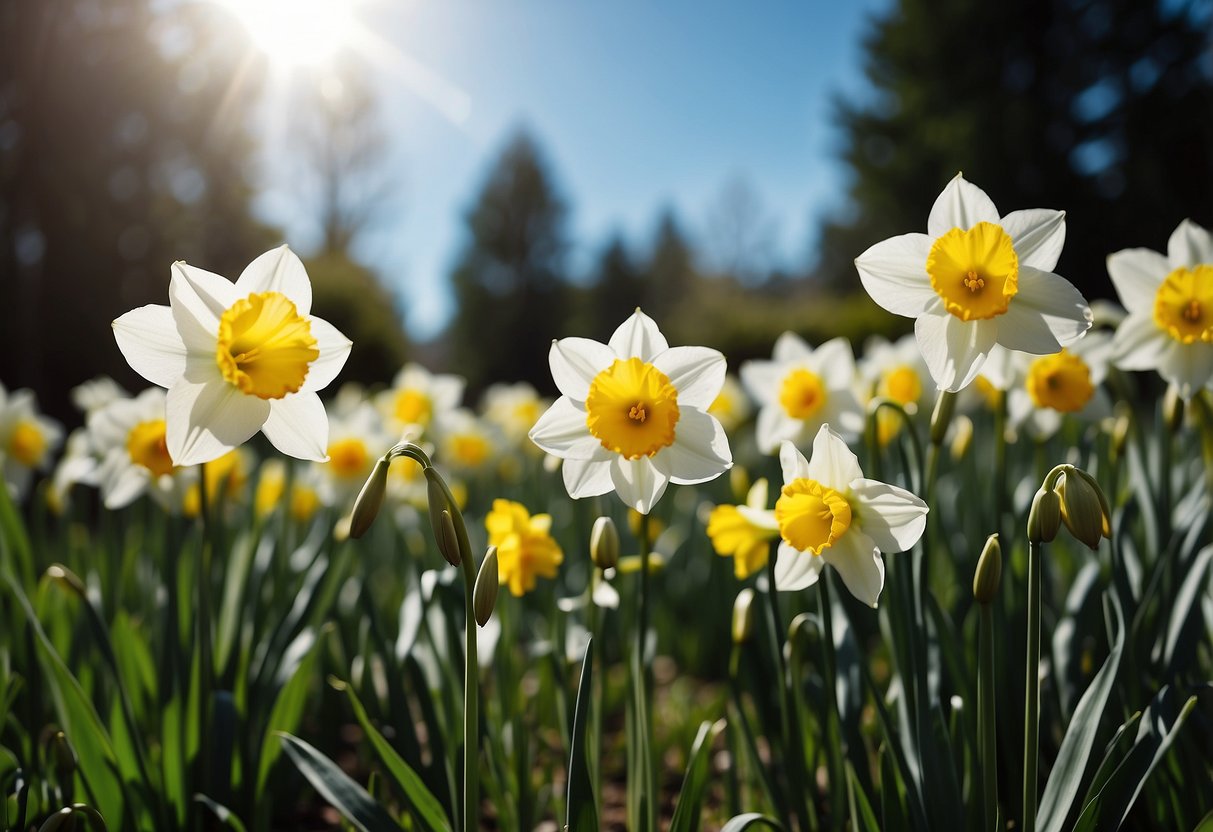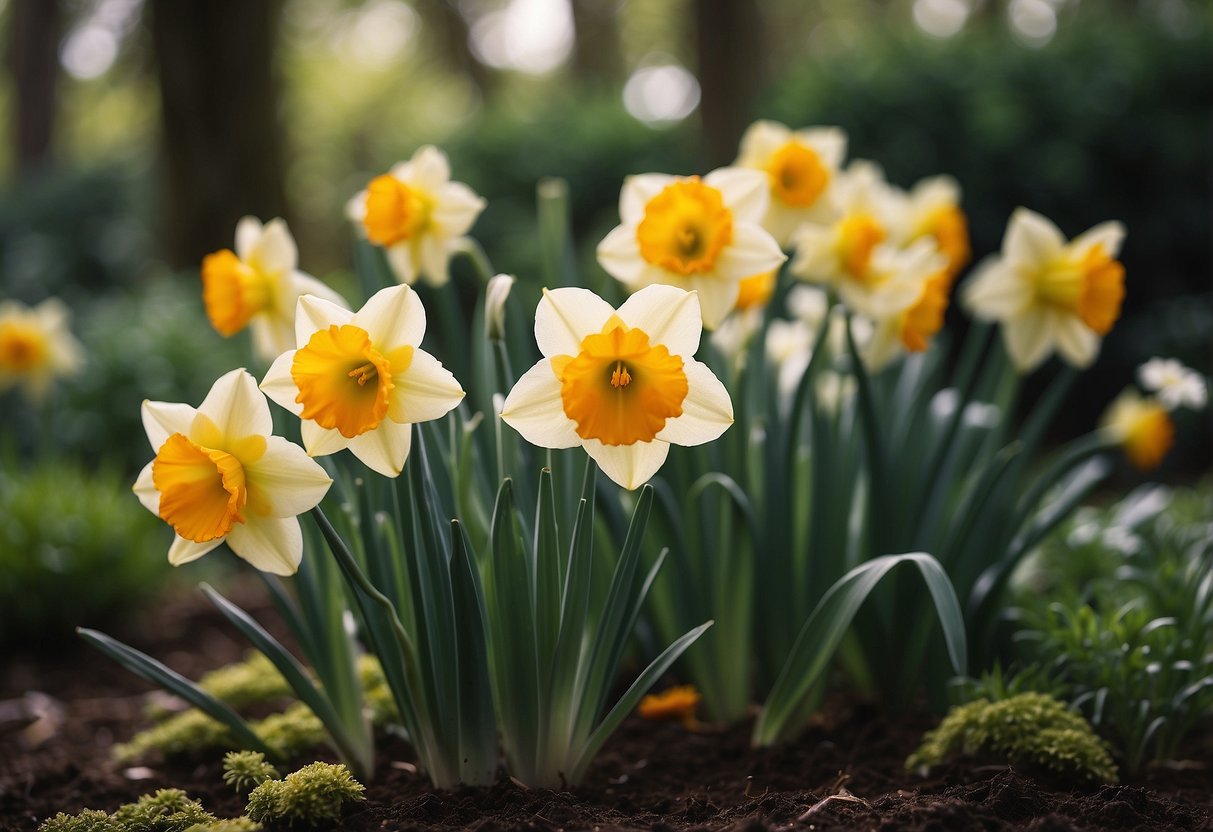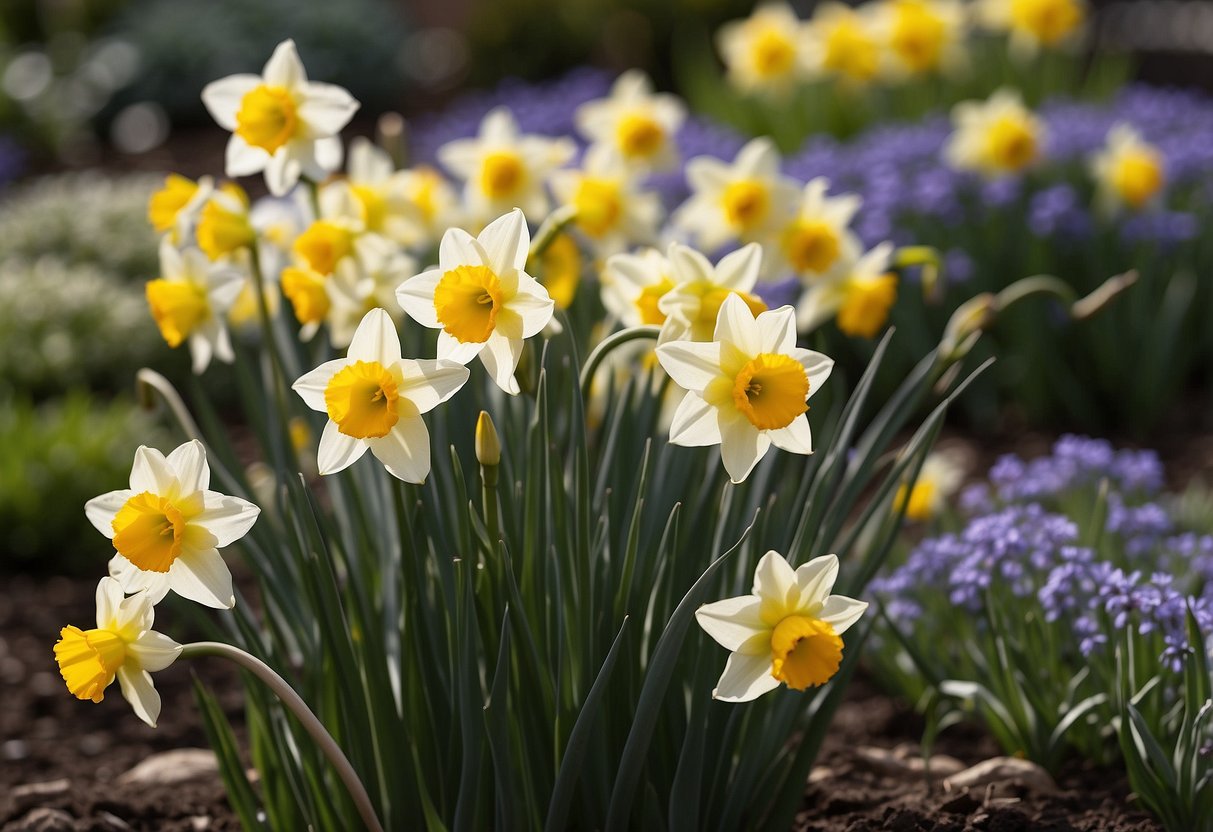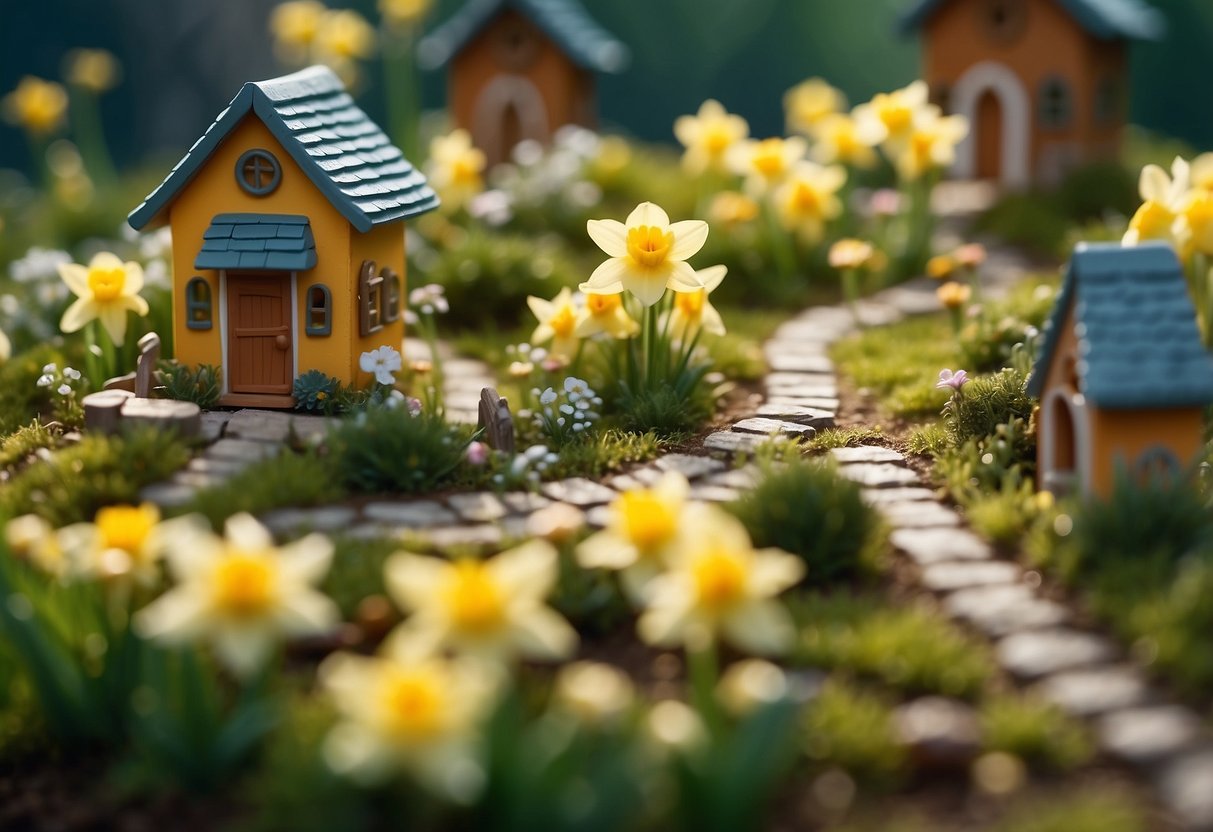Daffodil Garden Ideas: Brighten Your Spring Garden
Are you thinking about adding some vibrant charm to your garden? Daffodils are the perfect choice for a splash of color and elegance. These delightful flowers not only brighten your garden but also offer a range of varieties and styles to suit any landscape.

What makes daffodils a great addition to your garden? They are easy to plant and care for, making them a favorite among both novice and experienced gardeners. With so many creative planting ideas, you can transform your garden into a stunning display that keeps blooming year after year.
1) Create a Multi-Colored Daffodil Display

To create a vibrant garden, mix daffodils of various colors.
Choose bulbs that bloom in shades of yellow, white, orange, and pink.
Plant them in groups to make bold, eye-catching patches.
Use slow-release fertilizer when you plant the bulbs, and water them well.
Keep the soil moist and add mulch.
Deadhead spent blooms to keep your garden looking fresh.
2) Design a daffodil border along walkways

Designing a daffodil border along your walkway can create a cheerful and inviting path. Choose different varieties of daffodils to ensure a mix of colors and blooming times. This way, your walkway will stay vibrant longer.
Space the bulbs evenly so each flower has room to grow. About four to six inches apart is ideal. You can also mix in other spring flowers like tulips for added color. For some creative ideas, you might find Pinterest has great suggestions.
Planting daffodils in groups, rather than in a straight line, can also add visual interest. These borders create beautiful, eye-catching edges along sidewalks or garden paths.
3) Plant daffodils for early spring blooms

Planting daffodils is a great way to add some early spring color to your garden. Choose a sunny spot with well-draining soil.
Plant the bulbs in the fall, 6 to 8 weeks before the first hard frost. Make sure to plant them at a depth twice the height of the bulb.
Keep the soil moist, especially during dry weather. Enjoy the cheerful yellow blooms in the spring and watch your garden come alive. For more detailed information, check out this guide.
4) Combine daffodils with tulips for vibrant color

You can create a stunning garden by combining daffodils and tulips. These flowers bloom at different times, ensuring color throughout the spring.
To plant daffodils and tulips together, make sure the soil is well-drained. This prevents the bulbs from rotting.
Plant daffodil bulbs deeper than tulip bulbs. This keeps their roots from interfering with each other.
Space the tulip bulbs about 4 inches apart and the daffodil bulbs 6 inches apart. This allows each flower enough room to grow beautifully.
For more details, you can refer to this guide for planting daffodils and tulips together.
5) Use daffodils to create a naturalized look

You can create a beautiful, naturalized look by planting daffodils in informal clusters.
This style is more relaxed compared to neat rows.
Simply dig holes about six to eight inches deep. Add some compost or worm castings for extra nutrients.
Place the bulbs with the pointy end up. Cover them with soil and give them a good watering.
Choose sunny spots with well-drained soil. Avoid low-lying areas that stay wet.
Explore more tips on creating a naturalized daffodil planting at Gardener’s Path.
6) Plant daffodils in containers for patios

Planting daffodils in containers is a great way to brighten up your patio. Choose a pot that is at least 6 inches deep with drainage holes to prevent waterlogging.
Fill the pot with potting soil, leaving about 2 inches of space at the top. Place the bulbs with the pointed end facing up, and cover them with soil.
For the best results, put the container in a sunny spot. Daffodils don’t require much fertilizer, but you can use a balanced fertilizer once a year in the spring. Enjoy the cheerful display of blooms on your patio!
7) Mix Daffodils with Perennials for Layered Look

Mixing daffodils with perennials can make your garden look more layered and appealing. Perennials like hellebores and irises bloom at different times, adding color when the daffodils start to fade.
Choose plants with various heights and textures to create more interest. This will keep your garden looking lively throughout the growing season.
By mixing daffodils with perennials, you’ll enjoy a beautiful, low-maintenance garden that changes throughout the year.
8) Create a daffodil rock garden

Creating a daffodil rock garden can be a charming way to brighten up your space. Start by choosing a sunny spot since daffodils love sunlight.
Arrange rocks of different sizes to form an appealing pattern. Place daffodil bulbs in the gaps between the rocks. Use a mixture of soil, sand, and pebbles for planting.
Combining daffodils with other small plants, like Scotch moss, adds texture and color. This setup helps the plants thrive and creates a vibrant display in your garden.
9) Design a daffodil-themed fairy garden

Choose a sunny spot where daffodils can thrive. Daffodils come in many colors like yellow, white, and peach, so mix different varieties for a vibrant look.
Add tiny fairy houses among the daffodils. Make paths using small stones or pebbles. Include moss and creeping thyme to cover the ground and give it a magical feel.
Use miniature accessories like benches, swings, and tiny animals to complete your fairy garden. Add a small water feature for a touch of tranquility. Your daffodil-themed fairy garden will be a charming addition to your outdoor space.
10) Plant daffodils in window boxes

Daffodils can bring a bright splash of color to your windows. They grow well in pots and are easy to manage.
Choose a pot that is at least 6 inches deep and has drainage holes. Fill it with potting soil, leaving a couple of inches at the top.
Plant the bulbs with the pointed side up, about twice as deep as the bulb itself. Water the soil well and place your window box where it can get plenty of sunlight.
For a pretty display, try the ‘Ice Wings’ variety with its beautiful white, scented flowers. It’s a great choice for a cheery window box.
Learn more about planting daffodils in pots and get inspired to brighten up your windows.
Planning Your Daffodil Garden

To create a beautiful daffodil garden, you need to select the best location and prepare the soil correctly. These steps ensure healthy, vibrant blooms.
Choosing the Right Location
Choosing the right location for your daffodils is crucial. These flowers prefer full sun, which means they need at least six hours of direct sunlight each day. This helps them grow strong and produce plenty of blooms.
If possible, avoid planting in areas with heavy shade, as this can limit the growth and flowering. Daffodils also like well-drained soil. If the soil holds too much water, the bulbs can rot. Make sure the location you choose doesn’t flood easily after rain.
Consider planting near other spring-flowering plants that enjoy similar conditions. This can create a colorful display in your garden. Additionally, think about placing daffodils along borders, walkways, or even in large containers. They are versatile and can fit in many garden styles.
Soil Preparation
Preparing the soil properly makes a big difference in how well daffodils grow. Start by loosening the soil to a depth of about 12 inches. This helps the roots to spread easily and access nutrients.
Mix in organic matter such as compost or well-rotted manure to improve soil structure and drainage. This enriches the soil with nutrients, giving the bulbs a healthy start. You can also test the soil pH; daffodils prefer slightly acidic to neutral soil, around pH 6.0-7.0.
If necessary, adjust the pH by adding lime to raise it or sulfur to lower it. Make sure the soil is crumbly and not too compact. Good soil structure helps bulbs grow better and prevents water from stagnating around the roots. Following these steps ensures your daffodils get the best start and thrive in their new home.
Daffodil Varieties to Consider

When planning your daffodil garden, it’s important to know about both the classic and the exotic varieties to create a beautiful and diverse display.
Classic Yellow Varieties
Yellow daffodils are the quintessential spring flower. One popular choice is the ‘Jetfire’ daffodil, which boasts golden petals and a bright orange trumpet. These bloom in early spring and grow about 14 inches tall. They thrive in full sun or partial shade.
Another favorite is the ‘Mount Hood’ daffodil. Known for its all-white flowers, it starts with a slight yellow hue that fades to pure white. This variety has won numerous awards for its beauty and vigor. It usually blooms in mid-spring and reaches up to 16 inches in height, perfect for any garden setting.
The ‘Ryan Daffodil’ is another must-have. This early-blooming variety features large yellow trumpets and outer petals. It grows about 18 inches tall and is excellent for borders and mass plantings. These classic yellow varieties are essential for a traditional spring garden.
Exotic and Unique Strains
If you want to add some excitement to your garden, consider planting some exotic daffodil strains. The ‘Tahiti’ daffodil is an eye-catching double variety with buttery yellow petals and an orange-red center. These grow between 12 and 24 inches tall and bloom in early to mid-spring. They bring a tropical flair to any garden.
The ‘Mary Gay Lirette’ daffodil is quite unique with its true pink color, unlike most pink daffodils that lean toward apricot or salmon. Introduced in 2013, it adds a soft, romantic touch to your garden.
Another interesting choice is the ‘Replete’ double daffodil. This strain features layers of white and peach petals, creating a full and ruffled look. It is both seed and pollen fertile, making it great for breeding new plants. These can significantly enhance the diversity and color of your spring garden.







